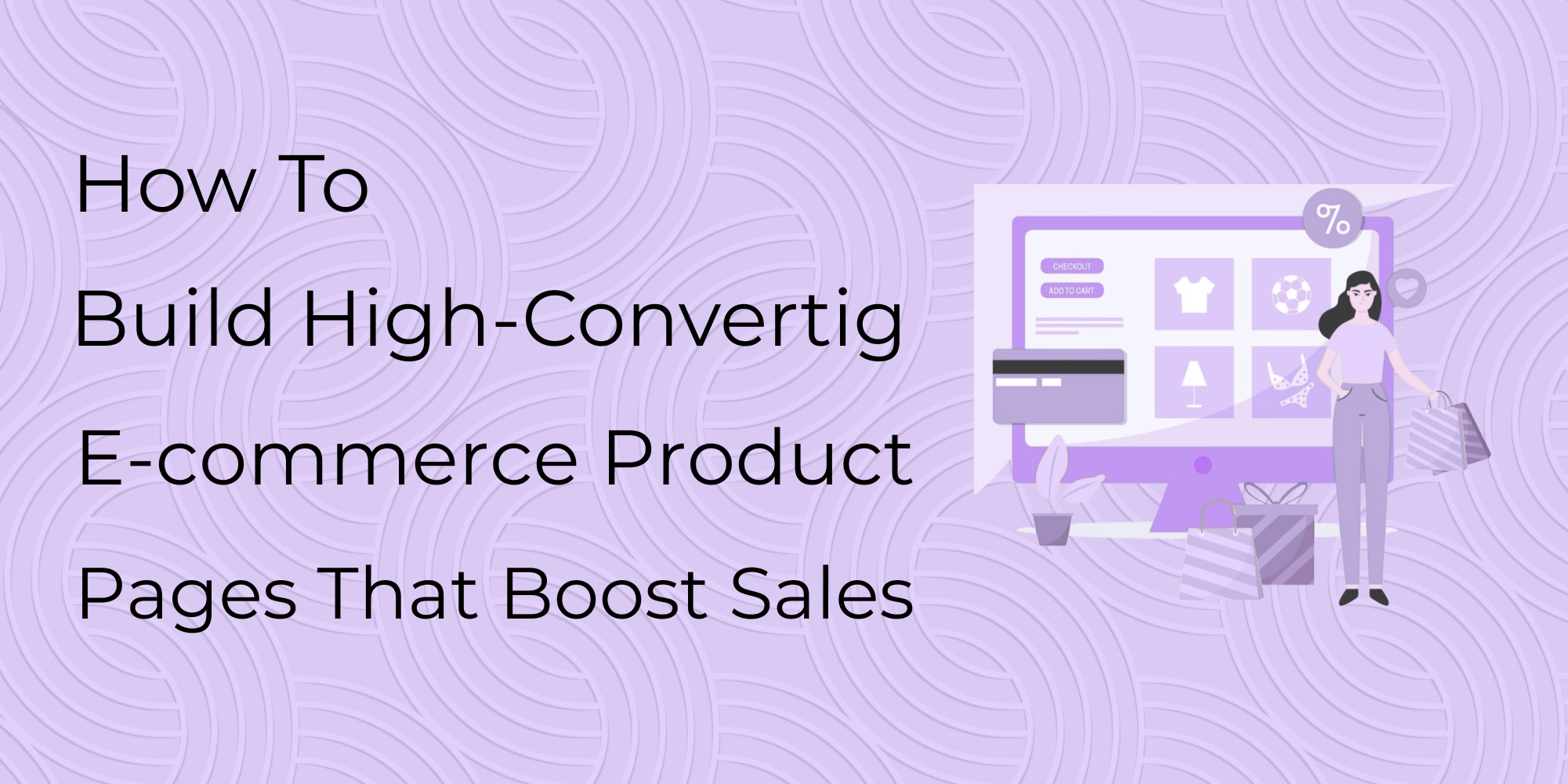Your e-commerce product page is the online equivalent of a bricks-and-mortar salesperson—it’s where shoppers determine whether to buy, browse, or bounce. With an overcrowded online market, having an attractive store is not enough; your product pages need to convert browsers into paying customers.
- Know the Role of a Product Page
A product page is not simply there to present an image and a price tag. It has only one purpose: to convince the visitor to buy. Every design decision, word of copy, and interactive feature must support this objective.
An effectively optimized product page ought to:
- Clearly state what the product is and why it’s worth it.
- Establish trust by way of imagery, reviews, and guarantees.
- Minimise friction by making buying easy.
- Create emotion — make the customer feel that they must have the product.
- Employ High-Quality, Conversion-Focused Product Images
Human beings are visual buyers. Indeed, more than 75% of online consumers use product images when making purchasing decisions.
Best practices for product photography in e-commerce:
- Multiple angles: Feature the front, back, sides, and close-ups. Let buyers envision holding the product.
- Add lifestyle images: Don’t simply present the product — present it being used. For instance, present a yoga mat in use during a home workout, not simply rolled up on the floor.
- Introduce zoom functionality: buyers want to examine details, texture, and quality.
- Make load times snappy: Compress images without compromising quality. Slow-loading pages kill conversions.
- Visualise product variations: in case you offer various colours or sizes, show them with clickable thumbnails.
Pro tip: Include a 360° product view or a brief demo video. Pages with product videos convert up to 80% higher than those without, based on research.
- Create Engaging, Benefit-Oriented Product Descriptions
Your product description is your quiet salesperson. It needs to inform, engage, and convince — all simultaneously.
The secret is to sell benefits, not features.
- Feature: “This smartwatch lasts 48 hours on a single battery charge.”
- Benefit: “You can stay connected all weekend without having to recharge.”
Here’s the formula for writing great product descriptions: - Begin with the problem your product eliminates. What pain does it take away from the customer?
- Emphasise benefits and emotional hooks. How will the customer feel once they’ve purchased it?
- Bullet points for scannability. Shoppers browse — make important information quickly accessible.
- Use sensory and active words. Terms such as “luxurious”, “effortless”, or “crisp sound” stimulate imagination.
- Add SEO keywords organically. Imagine your customer: what would they search for?
Example:
Instead of saying, “Our candle is made from soy wax,” say, “Hand-poured soy wax candle that burns cleanly for up to 50 hours—creating a warm, cosy atmosphere you’ll never want to leave.”
- Craft an Irresistible Call to Action (CTA)
Your CTA button is the bridge between interest and purchase. It should stand out visually and verbally guide users towards taking action.
CTA best practices:
- Contrasting colours so the button stands out.
- Short and to the point text: “Add to Cart,” “Buy Now”, “Get Yours Today”.
- Make urgent: “Limited Stock”, “Only 3 Left”, or “Ships Today”.
- Place CTAs above the fold and reiterate them lower on the page.
A/B testing CTAs can have a huge effect on conversion rates. For instance, revising a button from “Submit” to “Get Started” has raised conversions by more than 20% in some research.
- Use Social Proof Strategically
Customers trust fellow customers. 93% of customers report that reviews affect their purchasing decisions. Social proof instills confidence and eliminates doubt.
Social proof types to use:
- Customer ratings & reviews: Utilise a star rating system and feature best-rated reviews.
- User-generated content (UGC): Showcase customer images of them wearing/using your product.
- Testimonials or influencer endorsements: Real, genuine validation is magic.
- Trust badges: Show secure checkout, money-back promises, and SSL certification logos.
Pro tip: Answer bad reviews professionally. Sincere responses show honesty and care for customers, which gains long-term trust.
- Optimize for Mobile Experience
Mobile commerce represents more than 70% of online transactions, so product pages need to look and function ideally on smaller screens.
Mobile optimisation tips:
- Employ a responsive design that adjusts automatically with screen size.
- Provide large, clickable buttons for CTAs.
- Streamline layout — bury additional information behind collapsable tabs.
- Reduce checkout steps to a minimum (preferably fewer than 3 taps).
- Minimise loading time. Every second of lag drops conversions by some 7%.
- Include Clear and Transparent Pricing Info
Concealed fees or confusing pricing are among the leading causes of cart abandonment. Present all costs — including taxes and shipping — clearly up front.
Pricing practices that are conversion-friendly:
- Highlight the total price prominently next to the CTA.
- Indicate savings or discounts (“Was $99, now $79 — You save $20!”).
- Apply anchoring psychology: position a higher “compare-at” price alongside your price.
- Provide payment convenience — like “Buy Now, Pay Later” or instalment plans.
If your product deserves a higher price, then utilize your copy and imagery to describe the value — premium quality, handcrafted, eco-materials, etc.
- Pre-Emp Obligations Obstacle Handling
A high-converting product page has already anticipated buyer objections and addressed them in advance.
Typical objections and fixes:
- “Will it fit?” → Provide detailed size charts, guides, or AR try-on functionality.
- “Is it worth the money?” → Emphasise guarantees, materials, or longevity.
- “What if I don’t like it?” → Provide an effortless return or money-back guarantee.
- “Can I trust this site?” → Show trust badges and customer service contact information.
- Use Scarcity and Urgency Sparingly
Scarcity and urgency create the fear of missing out (FOMO), one of psychology’s strongest conversion levers.
Examples:
- “Only 5 left in stock.”
- “Sale ends in 2 hours.”
- “Join 2,000 happy customers who already purchased this.”
Key: Use urgency responsibly. Artificial scarcity can be counterproductive if customers feel cheated. Legitimate time-sensitive offers or seasonal promotions perform best.
- Optimize Page Speed and Performance
A slow product page is a faster killer of conversions than anything else. Google says 53% of mobile users abandon a site that loads in more than 3 seconds.
Make performance better by:
- Compressing images and adopting next-gen image formats (such as WebP).
- Reducing code and scripts.
- Using a fast, reliable hosting platform.
- Leveraging caching and CDNs.
- Include Clear Shipping, Returns, and Guarantee Policies
Trust drives conversions. Shoppers want to know what happens after they click “Buy”.
Make policies easy to find and simple to understand:
- Offer free shipping when possible (or set a free shipping threshold).
- Use clear delivery times (“Delivered in 3–5 business days”).
- Highlight return and exchange options.
- Provide a money-back guarantee to lower perceived risk.
Transparency minimises cart abandonment and generates brand loyalty.
- Apply Persuasive Copywriting Methods
Apart from structure and images, words themselves can destroy or create conversions.
Below are three successful copywriting methods:
- The Rule of Three: Truss benefits in threes — it’s more memorable.
Example: “Fast. Reliable. Affordable.” - Social Identity: Get the customer to feel like a part of a group.
Example: “Join 10,000+ professionals using this planner to stay organized.” - Storytelling: Cast your product in a relatable story.
Example: “Born out of a love of outdoor adventure, this jacket was created for adventurers who never want to stay indoors.”
Emotional connection = greater conversions.
- Use A/B Testing to Make Changes Constantly
Regardless of how clean your page is, there’s always potential for improvement. A/B testing enables you to test various versions of headlines, images, calls-to-action, and layouts to determine which works best.
Test concepts are:
- Button position and colour.
- Product names and descriptions.
- Visibility of reviews.
- Pricing formats.
- Page structure (tabs vs. long).
Data-driven decisions beat assumptions every time.
- SEO Without Compromising On User Experience
Search engine visibility guarantees consistent traffic — but your number one priority remains conversion.
SEO best practice on product pages:
- Primary keywords used in product title, URL, and meta description.
- Add rich result structured data (schema markup).
- Add FAQs to capture long-tail questions.
- Write distinctive descriptions (never rip off manufacturer copy).
- Optimise image alt text.
A converting, SEO-friendly page attracts traffic and converts it into sales.
- Establish Trust With Brand Personality
Customers don’t buy things — they buy from brands they like and trust. Your product page must show your brand voice, values, and personality.
- Employ a tone to match your brand (playful, professional, luxurious, etc.).
- Post a brief brand story or mission statement.
- Highlight ethical sourcing, sustainability, or craftsmanship if it’s applicable.
Authenticity breeds emotional connection — and emotion buys.
Final Thoughts
High-converting e-commerce product pages aren’t about trickery or gimmicks — they’re about psychology, clarity, and trust.
When your product page:
- stunningly displays the product,
- Appeals to customer wants and needs,
- Eliminates friction and doubt
- And makes purchasing easy…
…you don’t merely boost sales—you create long-term relationships with customers who return time and again.


